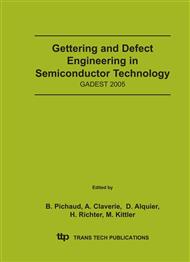p.309
p.315
p.321
p.327
p.333
p.339
p.345
p.351
p.357
Point Defects Interaction with Extended Defects and Impurities and Its Influence on the Si-SiO2 System Properties
Abstract:
The type and density of the point defects that are generated in the Si surface layer during thermal oxidation depend on the oxidation condition: temperature, cooling rate, oxidation time, impurity content. The interaction between point defects with extended defects and impurities affect the Si-SiO2 interface properties. The influence of point defects may be diminished and the interface properties improved by an appropriate choice of oxidation conditions.
Info:
Periodical:
Pages:
333-338
Citation:
Online since:
December 2005
Authors:
Price:
Сopyright:
© 2005 Trans Tech Publications Ltd. All Rights Reserved
Share:
Citation:


